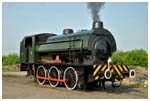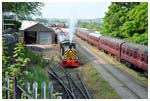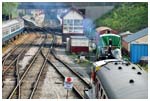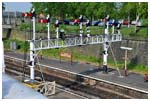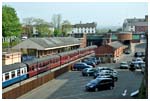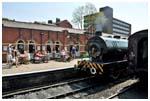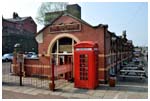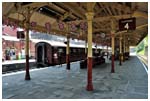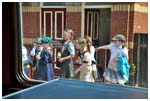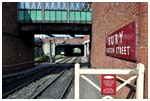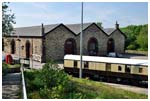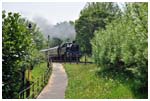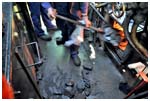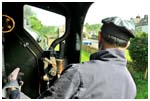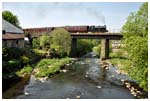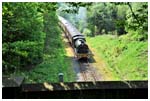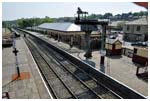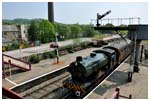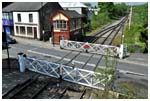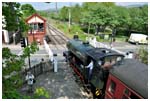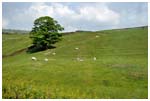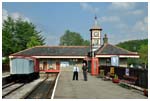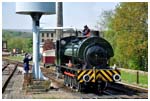East Lancashire Railway
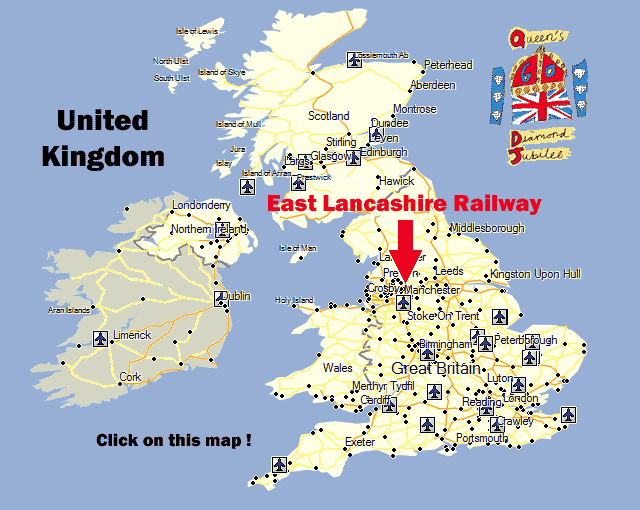
 Introduction Introduction
 The town of Bury is located approximately 10 miles north of Manchester travelling by Metrolink tram from Manchester Picadilly Station. The tram takes about 30 minutes for the trip. The East Lancashire Railway's Bury-Bolton Street station is an easy walk just a few blocks away from Bury's Metrolink tram station. During my two day visit to the East Lancashire Railway the green timetable was in effect. This meant that steam trains only operated between Bury and Rawtenstall missing Heywood entirely. The town of Bury is located approximately 10 miles north of Manchester travelling by Metrolink tram from Manchester Picadilly Station. The tram takes about 30 minutes for the trip. The East Lancashire Railway's Bury-Bolton Street station is an easy walk just a few blocks away from Bury's Metrolink tram station. During my two day visit to the East Lancashire Railway the green timetable was in effect. This meant that steam trains only operated between Bury and Rawtenstall missing Heywood entirely.
 Timetable Timetable
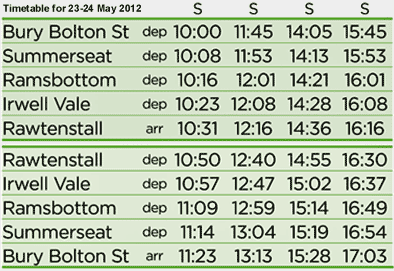
 Along the Way Along the Way
As you can see from the timetable it takes just 31 minutes to travel the line from Bury to Rawtenstall with three stops along the way. If you take your time it's easy to spend an entire day photographing and exploring the railway.
Heywood - This station is located about 4 1/2 rail miles to the east of Bury. On the days I visited there were no trains running to this location so there is little to be said about it. The satellite image on Google shows only a single platform at Heywood and no structures.
Bury - The East Lancashire Railway station is located on the south side of Bolton Street in Bury, hence the name Bury-Bolton station. The main entrance is at street level with stairs leading down to the platforms. Tracks run right through, beneath the station, beneath Bolton Street, and exit on the north side near the Bury Transport Museum. There is a building on the platform at the foot of the stairs which has been turned into a pub named "The Trackside Free House". A signal box named Bury South lies further to the south just beyond Jubilee Way. Still further south, near Baron Street, there is a shed, coaching stock, and various pieces of equipment stored in the open.
Summerseat - The first scheduled stop north of Bury is the tree shrouded platform on the east side of the track at Summerseat. A gravel road that parallels the track offers an easy walk north to the photogenic stone and steel bridge over the River Irwell. North of the bridge the track disappears into a tunnel approximately 300 metres long (1,500 feet).
Ramsbottom - Here lies a good sized village with a full station, two platforms, and a pedestrian over bridge connecting both platforms. A signal box immediately north of Bridge Street controls semaphore signals and the grade crossing with those familiar swinging white gates with the large red dot in the center. The over bridge offers a clear view of trains coming and going here. On one particular trip the crossing gates jammed blocking the train's progress causing a delay in the schedule, to the consternation of the engine driver. After some effort by the train's fireman and signalman they rectified the problem so the train could proceed.
Irwell Vale - Located between Ramsbottom and Rawtenstall this stop consists of one platform and a shelter. Several homes lie to the west hidden behind large deciduous trees but to the east the green land rises to a hill dotted with sheep, a typical English countryside scene.
Rawtenstall - This town lies at end-of-track. A stub-ended station blocks any further northward progress of the line. A run-around siding permits locomotives to clear their train and proceed to the south end of the platform where a water tower can replenish them before coupling to their carriages for the return journey.
 History History
The "Railway Mania" of the late 1830s-1850s saw businessmen all over the country forming railway companies and constructing lines to and from hundreds of different destinations. In Manchester, one group was proposing a railway from Manchester to the Rossendale Valley, via Bury. This resulted in the Manchester, Bury & Rossendale Railway (MB&R) forming in October 1843.
They appointed two men, Thomas Gooch and Charles Cawley, to survey a possible route. The route they chose diverged from the existing Manchester to Bolton line at Clifton and followed the River Irwell for much of its route to Bury, then continued via Ramsbottom to Rawtenstall, where it was to terminate. The line was not easy, with gradients of 1 in 96 and 1 in 132 for most of the way to Bury, but the directors approved the survey and appropriate action was taken to obtain Parliamentary permission. The Act received the Royal Assent on 4 Jul 1844.
While this was proceeding, the same group of businessmen were proposing a second company, the Blackburn, Burnley, Accrington & Colne Extension Railway (BBA&C), which would branch off the MB&R Railway at a point north of Ramsbottom, and head for Haslingden and then Accrington. At Accrington it would fork, the western fork joining the Blackburn and Preston Railway at Blackburn, and the eastern fork going on to Blackburn and Colne, where it would meet end of the Leeds and Bradford Extension Railway. The BBA&C Railway was authorised by Parliament on 30 Jun 1845. A further Act of 24 Jul 1845 authorised the amalgamation of the two companies under the banner East Lancashire Railway (ELR), and allowed the ELR to absorb the Blackburn and Preston Railway. Gooch and Cawley surveyed the Extension Railway.
On 23 Sep 1846, General Pasley of the Board of Trade gave the go ahead for the opening of the line from Clifton to Rawtenstall, which took place two days later. The first train, consisting of 18 carriages and 2 locomotives, left Victoria at 12:35 p.m. and reached Bury 35 minutes later. At Bury a further 15 carriages were added, and the train set off, to arrive in Rawtenstall half an hour later.
Meanwhile, work had commenced on the Extension Railway on 13 Oct 1845. Almost three years later, on 17 Jun 1848, the line was inspected by Capt. Wynne and the official opening took place two days later.
In 1848 the Lancashire & Yorkshire Railway (L&YR) proposed to extend its existing branch line, which ran from Blue Pits (now Castleton) to Heywood. It was to continue to Bury, where a new station, Knowsley Street, would be built.
It opened in November 1848. At the same time, the Liverpool to Bury Railway were building just that, and it then merged with the L&YR to provide a direct line from Liverpool and Wigan to Yorkshire.
The ELR ran trains over the L&YR's line from Salford to Clifton Junction, where their line branched off. The L&YR charged the ELR tolls according to the number of passengers, which worked well as tickets could be checked by L&YR officials at Clifton. However, when the ELR started to run express services, the L&YR still demanded that they stop at Clifton for their officials to check tickets. The ELR refused this, saying that they had nothing to hide and that their ticket ledgers were open to inspection at any time, but the L&YR were not convinced. The first express arrived at Clifton at 10:30 a.m. on 12 Mar 1849, but was made to stop by a group of L&YR plate layers who had chained a large timber beam across the track. When the train stopped, an L&YR official demanded tickets but, according to regulations, they had been collected at Radcliffe and he was told by the guard that there weren't any. Eventually, when eight trains from both railways had cluttered up the junction in a big "push of war", the L&YR officials quietly left, leaving their passenger superintendent, Henry Blackmore, in charge. Not wanting to face the angry passengers alone, he ordered the L&YR trains away. After the chaos had been sorted, the ELR train departed, two hours late, with triumphant crows from its whistle all the way to Salford. After this, the ELR considered its own route into Manchester via Whitefield and Cheetham Hill, but the L&YR came to terms and the Clifton to Manchester line was jointly operated.
Since early 1847, work had been underway on an extension of the ELR from Rawtenstall to Bacup, a town at the very end of the Irwell Valley. The line was only to be 4 1/2 miles long, and opened to Newchurch, two miles from Rawtenstall. on 27 Mar 1847. However, the next 2 1/2 miles were not to prove as easy. Three tunnels would be required, and the ELR directors were worried about the cost. Consequently, work did not proceed beyond Newchurch for another 3 years. Eventually, however, the line was completed, and opened on 1 Oct 1852.
In 1859, after thirteen years of competition, the ELR amalgamated with the ever-increasing L&YR. However, under the terms of the merger the ex-ELR headquarters and locomotive works at Bury remained in use.
In the 1870s, the large population around Cheetham Hill and Whitefield had caught the attention of the L&YR directors, so it was proposed to build a line branching from the existing Bury to Clifton line at a point near Radcliffe and proceed to Victoria via Whitefield, Prestwich, and Crumpsall. The line was subsequently built, opening to freight on 1 Aug 1879 and to passengers on 28 Aug 1879. However, Victoria Station had become so overcrowded that trains along this route could not fit into the station!
They had to terminate instead at Ducie Bridge, where temporary platforms were erected. It was not until 1882 that trains could continue to Victoria.
Also in 1882, a short branch off the Bury to Bacup line opened to Holcombe Brook. It left the Bacup line just north of Bury, and boasted three intermediate stations. Woolfold, Tottington, and Greenmount.
By the early twentieth century, Manchester Corporation's trams had reached as far north as Whitefield, and being right on everyone's doorstep, people started to switch from the trains to the trams. Therefore, to increase speed and efficiency, the L&YR decided that the best way to compete with the trams was to electrify their Bury to Victoria (via Whitefield) line. They were approached by Dick, Kerr and Company Ltd. who wished to experiment with electrifying a short section of line, ready for a possible future export. The L&YR agreed that they could use the Bury to Holcombe Brook branch, as its stations were close together and gradients were fairly steep. The line was electrified using 3,000 volt DC overhead cables, and the service commenced on 29 Jul 1913. However, that system did not prove adequate for the Bury to Manchester line, and the L&YR opted to electrify that route using 1,200 volt DC third rails. It opened on 17 Apr 1916 with a rake of brand-new electric multiple units, which were very luxurious in spite of the wartime lack of materials. Eventually the third-rail system replaced the overhead wires on the Holcombe Brook branch as well.
In 1922, the L&YR was absorbed by the London and North-Western Railway (LNWR). It stayed as that for just one year. until an Act of Parliament merged all Britain's railways into just four. These Big Four consisted of the Great Western Railway (GWR), the London, Midland and Scottish Railway (LMS), the London and North-Eastern Railway (LNER), and the Southern Railway (SR). The LNWR became part of the LMS.
On 14 May 1947, a fire struck the ex-ELR station building at Bury, destroying it completely. The new station building opened in June 1952.
At the beginning of 1948, following the emergency procedures of the Second World War, the railways were nationalised, and became known as British Railways (BR). It was after nationalisation that railways all over Britain began to close, and railways in the Bury area were no exception.
The first line to lose its passenger service was the relatively new Holcombe Brook branch. The last passenger service along the line ran on 5 May 1952, although freight services were to remain for over a decade. As a small consolation, the electric trains on the Bury to Victoria line were replaced by a brand new set of two-car units in 1959. These were later known by BR as class 504, and remained in service on the line until 1991 when the line was closed temporarily for conversion to the new Light Rapid Transit system.
On 1 Jan 1963, a new British Railways Board (BRB) was created to replace the abolished British Transport Commission. The chairman of the BRB was the famous Dr. Richard Beeching. His orders had been well defined by the then Prime Minister, Harold Macmillan, who told the House of Commons in March 1960, "The railway system must be remodelled to meet current needs and the modernization plan must be adapted to this new shape... This will involve certain sacrifices... for example in the reduction of uneconomic services." Beeching's 1963 document entitled "The Reshaping of British Railways" (commonly known as The Beeching Report) announced that lines and stations that lost money were to be closed.
As a result of the Beeching Cuts, the Radcliffe to Clifton, Stubbins to Accrington, and Rawtenstall to Bacup lines all closed on 5 Dec 1966. The Bolton to Rochdale line (via Heywood and Bury Knowsley Street) followed suit on 5 Oct 1970, and the Bury to Rawtenstall line closed to passengers on 3 Jun 1972. Electric trains from Victoria then terminated on platform 3 at Bury (Bolton Street Station). In 1980 the new Bury Interchange opened, resulting in all passenger services to Bury being redirected along a new spur of line into the Interchange. The last freight train on the Bury to Rawtenstall line ran in December 1980, ceasing all traffic through Bolton Street Station.
Luckily, thanks to the volunteers of the East Lancashire Railway Preservation Society, steam hauled passenger trains ran again from Bury to Ramsbottom from 25 Jul 1987, and on to Rawtenstall from 27 Apr 1991. Services to Heywood were resumed on 6 Sep 2003, making the total running length of the line operated by the East Lancashire railway to 12 miles.
Locomotives and rail tours can be brought into the East Lancashire Railway from the main line over the Heywood link from Castleton, and plans to extend the East Lancashire Railway to a new interchange station with the main line at Castleton are currently under consideration. When achieved, this will provide the stations of the Preserved railway with a direct link via the main line to Rochdale, Leeds, Bradford, and Manchester Victoria, benefiting both the local Inhabitants, and the preserved railway.
In 2010 following a £3 million renovation programme the Bury Transport Museum was reopened by HRH the Duke of Gloucester. The museum is housed in the former 1848 Castlecroft Goods warehouse of the East Lancashire Railway, adjacent to Bury Bolton Street station.
The East Lancashire Railway has featured in a number of TV programmes including:
· "The Grimleys" in 2001;
· "Life on Mars" in 2007;
· "Coronation Street" (Roy and Haley's wedding) in 2010;
· and more recently the BBC television film "Eric and Ernie" depicting the early careers of the comedy duo Morecombe and Wise, when Bury Bolton Street Station was featured with a steam train of Mark 1 coaches.
A.R.J. Walker - 1992 - Revised 2011.
 Folders Folders
Several folders published for the 2012 season are displayed below.
Click on them to view a larger image.
 East Lancashire Steam Locomotives East Lancashire Steam Locomotives
| Number | Name | Wheel Arrangement | Built | Builder | | | | | | | SR 35027 | Port Line | 4-6-2 | ? | ? | | SR 35002 | Holland America Line | 4-6-2 | ? | ? | | LNER 4472 | | 4-6-2 | ? | ? | | NWGB 1 | Barclay | 0-4-0ST | ? | ? | | MSC 32 | Gothenburg | 0-6-0T | ? | ? | | P&S 1370 | May | 0-4-0ST | ? | ? | | GWR 3855 | | 2-8-0 | ? | ? | | GWR 7229 | | 2-8-2T | ? | ? | | SR 34073 | 249 Squadron | 4-6-2 | ? | ? | | SR 35009 | Shaw Savill | 4-6-2 | ? | ? | | LMS 42765 | | 2-6-0 | ? | ? | | LMS 44871 | (Black Five) | 4-6-0 | ? | ? | | LMS 45337 | (Black Five) | 4-6-0 | ? | ? | | LMS 45407 | Lancashire Fusilier | 4-6-0 | ? | ? | | LMS 46428 | | 2-6-0 | ? | ? | | LMS 47324 | Jinty | 0-6-0T | ? | ? | | LNER 61572 | | 4-6-0 | ? | ? | | BR 71000 | Duke of Gloucester | 4-6-2 | ? | ? | | BR 80097 | | 2-6-4T | ? | ? |
 News Articles News Articles
14 Oct 1851 - East Lancashire Railway
23 Oct 2003 - Vandals Derail Steam Loco
11 Dec 2003 - Horror Train Crash Relived by Daughter
25 Jul 2007 - Nazi Uniforms Banned at Lancashire Railway WWII Event
9 Jan 2009 - East Lancashire Train Station Signs Up for Auction
22 Oct 2009 - New Children's Books on East Lancashire Railway Steam Train
11 Mar 2012 - Flying Scotsman Tested on East Lancashire Railway
9 Jun 2012 - Rail Tragedy Investigation Focuses on Locking Device
 Bibliography Bibliography
 Scenes From The Past: 33 East Lancashire Lines Bury to Heywood & Rawtenstall Scenes From The Past: 33 East Lancashire Lines Bury to Heywood & Rawtenstall
J. Wells and E.F. Bentley
Year unknown
112 pages card cover
Size unknown
Foxline Publications
Cost unknown
 Railway Moods: The East Lancashire Railway Railway Moods: The East Lancashire Railway
Mike Heath
2006
144 pages hardcover
23.4 x 21.6 centimetres
Devon Books
£12.74 (Amazon)
 East Lancashire Railway by Night East Lancashire Railway by Night
Mike Heath
2009
144 pages hardcover
23 x 21.6 centimetres Halsgrove
£14.24 (Amazon)
 Spirit of the East Lancashire Railway Spirit of the East Lancashire Railway
Mike Heath and Karl Heath
2010
64 pages hardcover
15.8 x 11.4 centimetres
Pixz Books
£4.99 (Amazon)
 The East Lancashire Railway The East Lancashire Railway
Mark Bowling
2011
96 pages paperback
24.6 x 22.4 centimetres Amberley Publishing
£9.04 (Amazon)

Tales of Jimmy the Jinty
Michael Moore
2009
16 pages paperback
21 x 14.7 centimetres East Lancashire Light Railway Company
£2.00
 Associated Web Sites Associated Web Sites
East Lancashire Railway
East Lancashire Railway Diesel Group
The East Lancashire Railway Preservation Society
Photographs of East Lancashire Railway
UK Train Sim East Lancashire Railway
East Lancs Railway Baron Street Works
East Lancashire Railway Official Flickr Group
Atlantic Video View
East Lancashire Railway 2012
Video - Evacuation of children during World War II
Network Rail

| Vancouver Island
British Columbia
Canada
|
|

